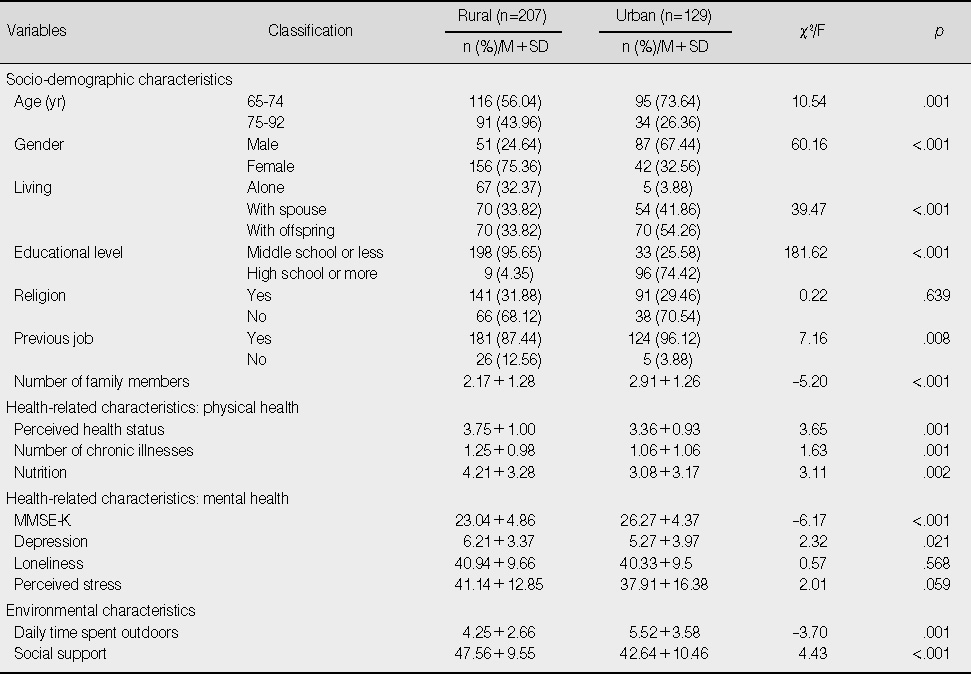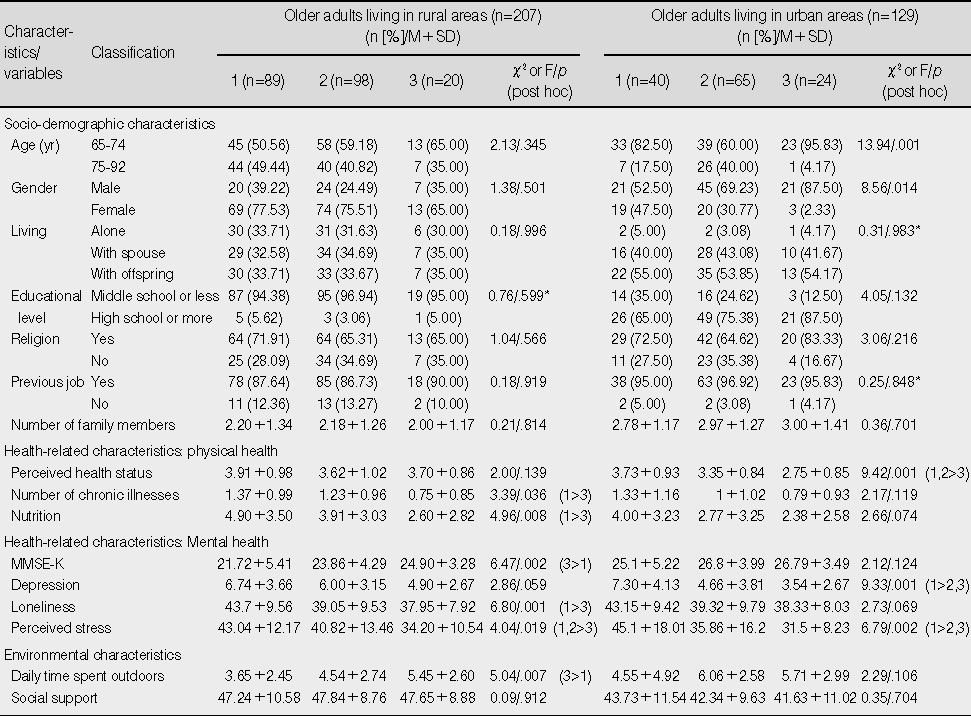Articles
- Page Path
- HOME > J Korean Acad Nurs > Volume 40(2); 2010 > Article
-
Original Article
- Predictors of Physical Activity in Korean Older Adults: Distinction between Urban and Rural Areas
- Seungmi Park, Yeon-Hwan Park
-
Journal of Korean Academy of Nursing 2010;40(2):191-201.
DOI: https://doi.org/10.4040/jkan.2010.40.2.191
Published online: April 30, 2010
1Full-time Lecturer, Department of Nursing · The Research Institute for Basic Sciences, Hoseo University, Asan, Korea.
2Associate Professor, College of Nursing · The Research Institute of Nursing Science, Seoul National University, Seoul, Korea.
- Address reprint requests to: Park, Yeon-Hwan. College of Nursing, Seoul National University, 28 Yeongeon-dong, Jongno-gu, Seoul 110-799, Korea. Tel: 82-2-740-8846, Fax: 82-2-765-4103, hanipyh@snu.ac.kr
Copyright © 2010 Korean Society of Nursing Science
Figure & Data
REFERENCES
Citations

- Factors Influencing Physical Activity and Exercise in Older Adults during COVID-19 in South Korea
Kyunghwan Jung, Younglae Choi
Sustainability.2023; 15(9): 7482. CrossRef - Factors Affecting Physical Activity Levels among the Korean Elderly with Osteoarthritis: Focusing on Gender Differences
Yeo-Won Hwang, Eun-Jung Bae
Korean Journal of Health Promotion.2023; 23(4): 171. CrossRef - Comparison of Sleep Disturbance, Physical Activity, and Health-Related Quality of Life According to Depressive Symptoms in Patients with Metabolic Syndrome: A Secondary Analysis from the Korea National Health and Nutrition Examination Survey Using a Prope
Jungmi Yun, Yunji Lee
Healthcare.2023; 11(12): 1802. CrossRef - Effects of a Person-Centered Nursing Intervention for Frailty among Prefrail Community-Dwelling Older Adults
Jiyeon Ha, Yeon-Hwan Park
International Journal of Environmental Research and Public Health.2020; 17(18): 6660. CrossRef - Factors related to the regular exercise participation of middle-aged and older people
Yongha Seo, Seungjae Hyun, Sangshin Park
Korean Journal of Health Education and Promotion.2020; 37(5): 23. CrossRef - Effect of an Integrated Healthcare Program for Korean Rural Older Adults: A Quasi-Experimental Study
Hyuk Joon Kim, Hye Young Kim, Youngran Yang, Eun Ko
Healthcare.2020; 8(3): 244. CrossRef - Factors Associated with Physical Activity in Older Adults by Region: Based on the 2017 Community Health Survey
Hyun-Ju Lee, Yeongsuk Lee, Jungmi Yun
Journal of Korean Academy of Community Health Nursing.2020; 31(Suppl): 563. CrossRef - Nutrient deficiencies and depression in older adults according to sex: A cross sectional study
Yeon‐Hwan Park, Smi Choi‐Kwon, Kyung‐Ae Park, Minhee Suh, Young‐soon Jung
Nursing & Health Sciences.2017; 19(1): 88. CrossRef - The Effect of Health Coaching Programs on Self-Efficacy, Health Behaviors, and Quality of Life in Hypertensive People Living in Poverty
Sun Ok Eom, Insook Lee
Journal of Korean Academy of Nursing.2017; 47(3): 380. CrossRef - Predictive Factors on Level of Physical Activity in the Community Dwelling Elderly
Yeong-Mi Seo, Mal-Soon Kang, Mi-Yang Jeon
Journal of the Korea Convergence Society.2016; 7(6): 151. CrossRef - Sports injuries and the changes in physical activity, perceived health state and exercise self-efficacy according to the sports injuries of the elderly who participate in physical activities
Kyung Hee Seo, Young Eun, Mi Yang Jeon
Journal of Korean Biological Nursing Science.2016; 18(2): 102. CrossRef - Relationship Between the Physical Activity Levels and Health Care Utilization in Korean Elderly
Kwang-Il Kwak, Chang-Hee Baek, So-Yeon Ryu
Journal of the Korea Academia-Industrial cooperation Society.2015; 16(1): 617. CrossRef - The effect of a urinary incontinence self-management program for older women in South Korea: A pilot study
Jennie C. De Gagne, Aeyoung So, Bei Wu, Mary H. Palmer, Eleanor S. McConnell
International Journal of Nursing Sciences.2015; 2(1): 39. CrossRef - Predictors of Maintenance of Physical Activity among Hypertensive Older Adults in Korea
Jin Yi Choi, Ae Kyung Chang, Eunju Lee
Journal of muscle and joint health.2015; 22(3): 228. CrossRef - Comparison of the effects of Korean mindfulness‐based stress reduction, walking, and patient education in diabetes mellitus
Hee Young Jung, Haejung Lee, Jina Park
Nursing & Health Sciences.2015; 17(4): 516. CrossRef - Factors Related to Physical Activities of Elderly with Hypertension between Urban and Rural Areas
Hyun-Hee Paek, Sok-Goo Lee
Journal of agricultural medicine and community health.2015; 40(2): 62. CrossRef - Factors Influencing Physical Activity in Elderly Women at Senior Citizen Centers
Kyung Hee Seo, Young Eun
Journal of muscle and joint health.2015; 22(3): 236. CrossRef - Nutritional Status and Risk Factors for Malnutrition in Low-income Urban Elders
Hye Sun Hyun, Insook Lee
Journal of Korean Academy of Nursing.2014; 44(6): 708. CrossRef - Literature Review for the Effects of Physical Activity on Musculoskeletal Outcomes in Community-dwelling Older Adults
Kyung Choon Lim, Jeung-Im Kim, Young Ran Chae
Korean Journal of Women Health Nursing.2014; 20(4): 297. CrossRef - Maintenance of Physical Function in Frail Older Adults
Carol E. Rogers, Maria Cordeiro, Erica Perryman
Nursing Clinics of North America.2014; 49(2): 147. CrossRef - A Study on Physical Activity and Related Factors to Physical Activity for the Elderly with Diabetes Mellitus
Hye-Yeon Kang, Mee-Ock Gu
Journal of muscle and joint health.2012; 19(1): 57. CrossRef - Effects of a regular walking exercise program on behavioral and biochemical aspects in elderly people with type II diabetes
Kiwol Sung, Sangkeun Bae
Nursing & Health Sciences.2012; 14(4): 438. CrossRef - Comparison of Healthy Life Style and Chronic Disease Management between Urban and Rural Older Adults
Jia Lee, Yena Lee
The Korean Journal of Rehabilitation Nursing.2012; 15(2): 100. CrossRef - A Comparison of Pain, Pain Interference and Fatigue according to the Level of Physical Activity in the Elderly with Chronic Pain
Bo Kyoung Cha, Chang Seung Park
Journal of Korean Academy of Community Health Nursing.2011; 22(2): 162. CrossRef - A Comparison of Pain, Pain Interference and Fatigue according to the Level of Physical Activity in the Elderly with Chronic Pain
Bo Kyoung Cha, Chang Seung Park
Journal of Korean Academy of Community Health Nursing.2011; 22(2): 161. CrossRef - Relationship of Daily Activity and Biochemical Variables in the Elderly with Diabetes Mellitus
Ki-Wol Sung
Journal of Korean Academy of Nursing.2011; 41(2): 182. CrossRef
Comparison of the Physical Activity between Rural and Urban Dwelling Elders (N=336)
MET (min/week)=MET level×minutes of activity×events per week; MET level=Vigorous intensity (8), Moderate intensity (4), Walking Moderate (3.3), Sitting (1).
Comparison of Characteristics of Rural and Urban Dwelling Elders (N=336)
Factors related to the Physical Activity in Rural and Urban Dwelling Older Adults (N=336)
* Fisher' exact test.
Logistic Analysis of Factors which Affected the Physical Activity of Rural Dwelling Older Adults (N=207)
CI=confidence interval.
Logistic Analysis of Factors which Affected the Physical Activity of Urban Dwelling Older Adults (N=129)
CI=confidence interval.
MET (min/week)=MET level×minutes of activity×events per week; MET level=Vigorous intensity (8), Moderate intensity (4), Walking Moderate (3.3), Sitting (1).
* Fisher' exact test.
CI=confidence interval.
CI=confidence interval.
 KSNS
KSNS
 E-SUBMISSION
E-SUBMISSION





 Cite
Cite

